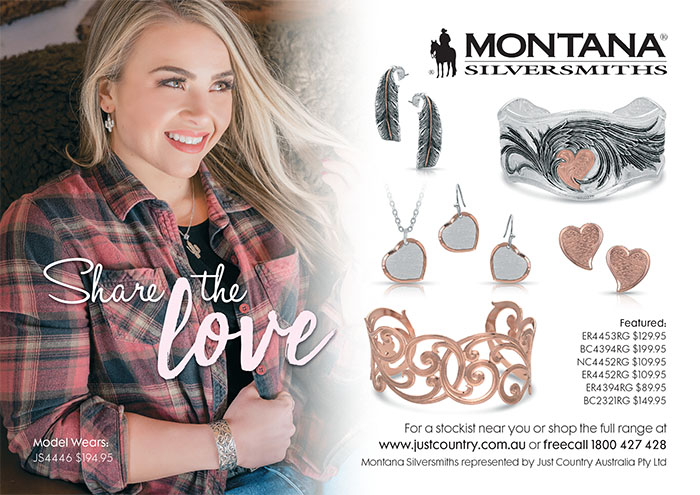Mary Wanless changed the way the riding world looked at and understood the way in which the rider’s seat and position influenced the horse. Here she looks at the importance of weight and the stirrup…
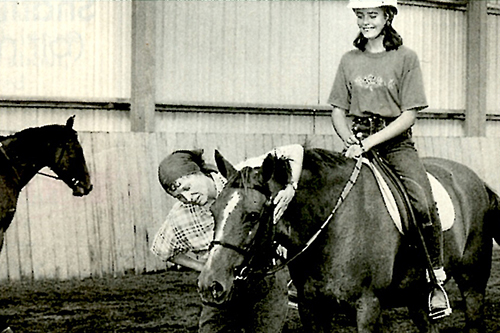
If you stand in an “on horse” position with your knees slightly bent,you can feel how your weight is distributed over your feet, with the balls of the feet taking most of it. If you slowly fold down into jumping position you will feel that your weight gradually rolls back onto your heels. The fact that you have stayed in balance over your feet throughout this manoeuvre demonstrates that you have not lost responsibility for your body weight – this is important, because a loss of balance can endanger you and turn you into a burden that impairs your horse’s jumping style.
But look at this the other way round. The change in the weight bearing area (from primarily on the balls of the feet to primarily on the heels has demanded a total change in your body position – from the upright position of flatwork to the fold down that you show over fences. To me it seems amazing that this change in balance point, which is probably no more than seven or eight inches, can have such huge ramifications.
Story continues below the advertisement
But very few riders demonstrate this change in balance so clearly when they are actually astride a horse, and the vast majority of riders I see are pushing their heel too far down and forward in flatwork, whilst at the same time finding that it flies too far back and up when they are in flight over a fence.
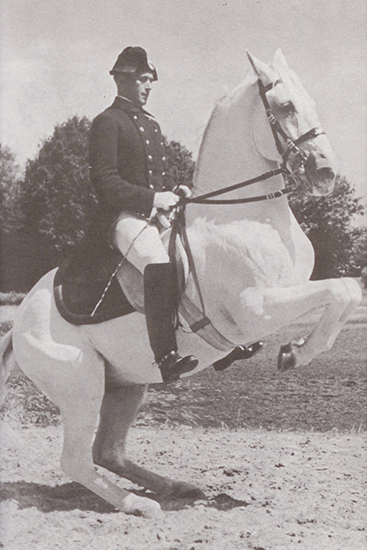
Think of photographs you have seen of riders from the Spanish Riding School, who show an exemplary flatwork position with a shoulder/hip/heel vertical line. Although we often hear this spoken about, it is much less often done: perhaps this is because there is an inherent contradiction between this idea and the concept of having the inside leg “on the girth”. It is impossible to do both at once, and most riders seem to opt for “on the girth”.
However, in flatwork riding I think this is a mistake – strictly speaking it is impossible, and the value of the term lies in the distinction that it makes between the positions of the inside and outside legs on a circle.
When I assess a rider’s flatwork balance, I ask myself two questions. The first is, “If I could whisk this rider’s horse out from underneath her by magic so that she dropped down onto the riding arena, how would she land on it?” Very often the answer is “on her backside”- as is inevitable if her upper body is upright and her lower leg is “on the girth”.
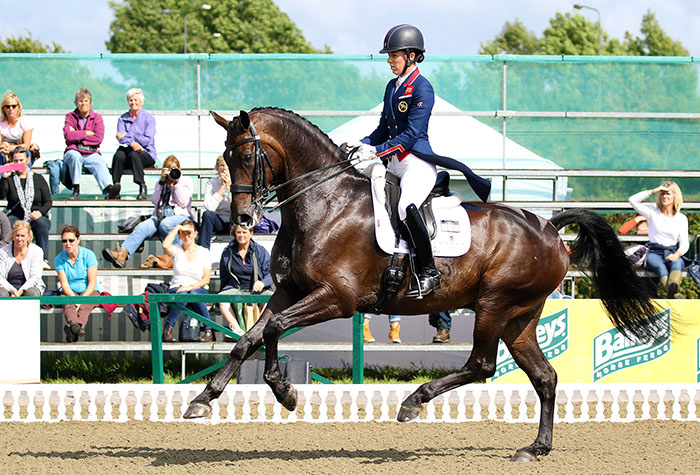
The classical rider with her shoulder/hip/heel line would land on her feet, and this tells us that she has maintained responsibility for her body weight (as does the correctly balanced jumping rider who has counter-balanced her leg position by folding from the hip).
The horse is then carrying a load which is in itself in balance: if you have ever carried a rucksack for any length of time you will know what a difference this makes.
story continues below the advertisement
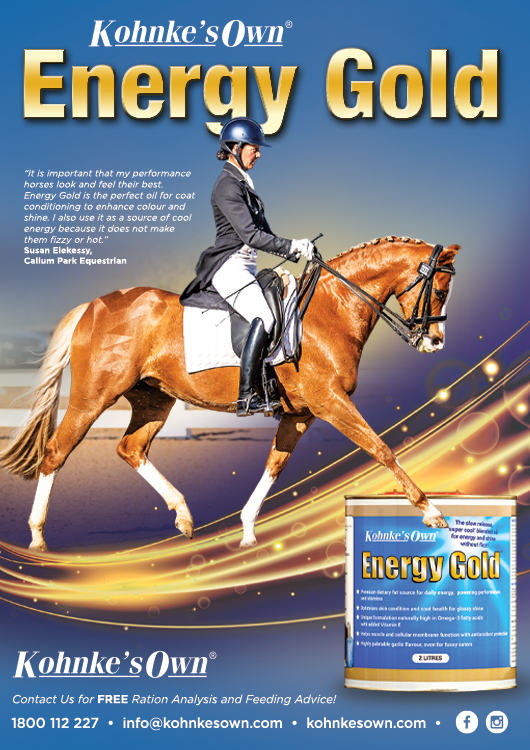
Another question which effectively assesses the same thing is, “Would the rider balance on a diving board?” I am drawing an analogy here between the rider’s balance over the stirrup, and the balance of a diver who stands on the edge of a diving board about to do a backward dive. Note that the diver’s weight is carried on the balls of her feet as they rest on the edge of the diving board. It is not carried in her heels; in fact when she wants to dive off she pushes her heels down and forward – mimicking the position of the out-of-balance flatwork rider. Yet most riders are convinced that their weight should be carried in their heels even in dressage riding, and the idea that it should be carried over the stirrups appears revolutionary.
“Push your heels down” seems to be a golden rule which is unquestioned, and considered true regardless of context, and of its effects. It seems to me that our riding theories and teachers have not made a clear enough distinction between the flat work balance and the jumping balance.
In response to the down and forward heel it is natural for the body to fold into jumping position. But another response is possible, especially when the jumping rider has her stirrups at dressage length. All too easily she counter balances on the reins, using the pull she has created to stop herself from falling over backwards. (Paradoxically, this same rider may also have a very unstable lower leg over fences – she is out of balance in both situations.) The classical dressage rider who maintains her correctly aligned body also has a lowered heel: but she achieves this by bringing her heel down and back, balancing over the stirrup like a diver on a diving board.
In practise many riders find this extremely difficult at first. If they are not allowed to push the heel forward , they find that they cannot get it down at all. This is hardest for riders who cannot squat on the ground without their heels coming up off the floor – this shows that their calf muscles have shortened. (Wearing high heeled shoes for any length of time encourages this to happen, as does a tendency to walk slightly on tip-toe.) If they can get the sole ofthe foot flat this is a good beginning – it at least puts the calf muscles under tension, creating the same effect that a lowered heel has on longer muscles.
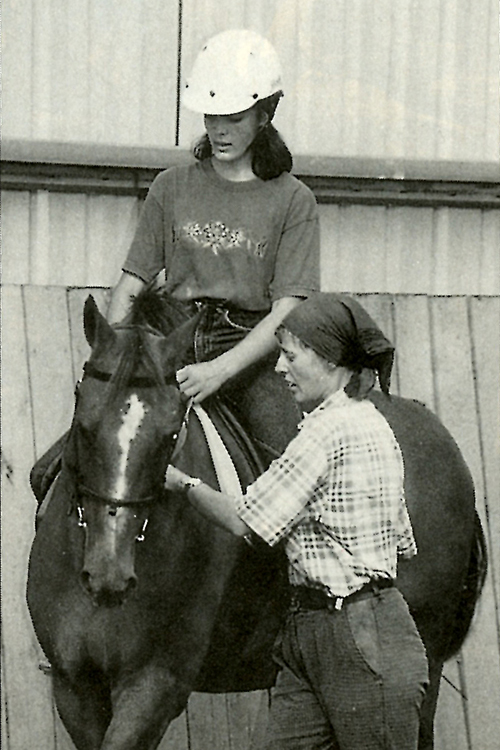
When the rider is in an “armchair seat” her weight is centred in the middle of the horse’s back, precisely in the point that is lowered when he hollows it.
The image of the ‘mantrap” helps to explain this:you have probably seen old movies showing how explorers in the African jungle used to catch animals by digging a pit and covering it with branches. The hollow in the horse’s back is the pit, and the thigh is like one of the branches – except that in this case it does not extend all the way back over the pit. The rider’s weight is stacked up above the free end of the branch, and she will inevitably fall down the pit unless it is counter-balanced by weight acting down through the knee. The thigh then acts as a lever, and using it correctly places tremendous strain on the thigh muscles. Instead of being like sitting in an armchair, the riders position becomes much more like kneeling.
To understand how this works in rising trot think of the manually operated barriers that are used at the entrances to army camps. The free end rises and drops without ever crash-landing into its casing. This is because it is counter-balanced by a heavy weight just the other side of the supporting column where the barrier pivots.
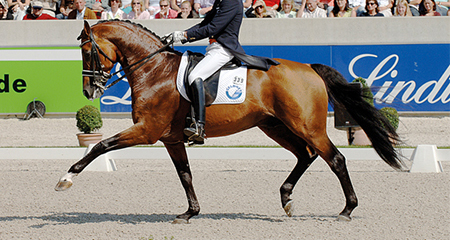
When the rider is in an “arm chair seat” it is impossible to bring the horse correctly “on to the bit”, for as she falls down into the “mantrap” she unknowingly perpetuates the hollow in his back.
Meanwhile, she is probably over-using her hand, and worrying about the position of his head. This puts the horse into a horrible contortion: try hollowing your own back and pulling your chin in. Most horses will do their utmost to get out of this position, whilst the saintly ones “give in” and offer a rather unconvincing imitation of dressage.
The truth is that correct head carriage comes on its own when the rider is able to draw the horse’s back up underneath her – hence my idea that the rider needs at least eighty percent of her attention in this area of her body.
The mechanics of the correct rider/horse inter-action can only work when she is ‘out of the mantrap’, with her body weight spread down her thigh and balanced over the ball of the foot. To gain sufficient body control she also needs the “bearing down” and “the pinch feeling”, which I have talked about earlier. In effect the horse’s back then comes up to the fill the space that is created as the rider’s thigh helps to support her body weight: her body acts almost like a suction device. This is as true on event horses as it is on dressage horses – in either field, there is no substitute for technically correct riding.
Want to read the whole article? Here it is…

